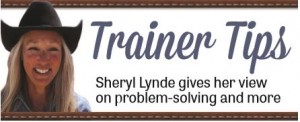 We are confronted with a multitude of distractions every day. It takes an ongoing awareness and effort to leave the world outside the arena in order to learn to focus on ourselves and our horse. Quieting your mind and letting go of distractions allows you to concentrate on your body and your horse’s movements. Attainment of any goal you set, whether it is mastering a specific maneuver or overcoming a habit you have judged as a bad one, depends on your mental game.
We are confronted with a multitude of distractions every day. It takes an ongoing awareness and effort to leave the world outside the arena in order to learn to focus on ourselves and our horse. Quieting your mind and letting go of distractions allows you to concentrate on your body and your horse’s movements. Attainment of any goal you set, whether it is mastering a specific maneuver or overcoming a habit you have judged as a bad one, depends on your mental game.
This takes an understanding of the “inner game” of your mind. It’s the first step that moves aside confusion and fear, replacing them with confidence regardless of the circumstances or surroundings. Being focused on each maneuver is just as instrumental to your training regime as the reins are to the bridle.
In the book “The Inner Game of Tennis,” author W. Timothy Gallway defines judging our efforts as a culprit that leads to trying too hard. For instance, when riders continually judge or place a negative value to a habit as “bad,” such as always leaning in turns, they will begin to identify themselves with the habit itself. They bring this identification to their riding lesson and their focus changes from being aware of what their body is doing to the mindset of what NOT to do.
Judgements are ego reactions to an occurrence. This provokes trying too hard, which promotes nervousness. The body becomes tight from trying, which inhibits movement. Muscles need to be loose to perform the necessary tasks at the time they need to be performed. These riders fear making a mistake, which are learning moments — the most effective process by which we learn. Thoughts are immersed in what NOT to do instead of what TO do. But energy flows where attention goes, and you are doomed to repeat your previous unwanted pattern.
The author was giving a lesson to a group of women. He instructed them to direct their awareness to the position of their feet as they hit the ball. He emphasized there was no right or wrong. He hit several balls to each woman without making any comments. The women were also quiet, absorbed in each other’s foot work. After all the women hit, he made a comment that all the balls had made it over the net and landed in one corner grouped together on the opposite court. Even though he simply stated an observation without attaching a judgement to the result, his tone implied that he was pleased. He repeated the same exercise and hit 30 additional balls to the women. The women seemed more nervous, their footwork became more erratic, and upon completion there were eight balls at the net — and the ones that had made it over were scattered on the other side of the court.
He asked the women what had changed. They stated that they had become less aware of the position of their feet and more concerned with NOT hitting the net.
The horse mirrors the actions of the rider’s body. If while circling the horse to the left, the horse dives into his turn or drops his inside left shoulder, the rider is usually leaning and putting more weight in the left stirrup. Replace judgements on what you do as being negative with awareness on feeling what your body is doing at the time you feel your horse lean. Feel where your shoulders are and make an adjustment. If they are in front of your hips, move them slightly behind and feel the difference this change in your body makes in your horse. This requires that you be “in the moment” and recognize when your horse begins to lean and focus on what your body is doing at that time.
By directing the rider to focus on putting more weight in their outside right sit bone and inside left calf with consistency, the horse’s habit of diving will be eliminated. Either way of riding isn’t bad or good, it just produces different results.
You do not become good by trying to be good, but by awareness of the good and strengths in you and your horse and allowing those abilities to develop and evolve. Trying to be good is forcing an outcome, and usually is tied to self-image. Developing feel and awareness of your body position at each step and how it impacts your horse’s movements will deliver an outcome that feels effortless because it is pure.
You “get” by giving. Great works are completed from an inner source that is still and absent of thoughts attached to fears, doubts, ego or outcome.
Seeing events as they are and not attaching judgements to them will change how you ride. Repetitive self judgements, being either good or bad, become self-fulfilling prophecies.
–Sheryl
Leave a Comment
All fields must be filled in to leave a message.